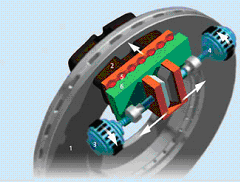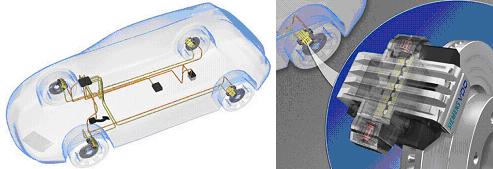With the Electronic Wedge Brake (EWB), you can now design 12V remote brakes! EWB was launched by Siemens VDO, an electronic and mechanical electronics developer at the Frankfurt Motor Show last year.
This article refers to the address: http://
Compared to conventional hydraulic brakes, the modern wedge brake (brake) design offers significant value in terms of safety and comfort and is expected to go into production by 2010.
Future advanced driver assistance systems will not only monitor the traffic conditions that are occurring, but also actively support the driver in an emergency. Through automatic intervention, these systems will play an increasingly important role in maintaining a controlled state of the vehicle under difficult conditions, one of which is a fast and intelligent braking system. Siemens VDO believes that the wire brake technology implemented in the form of EWB can meet the needs of future body safety, weight, reliability and installation space.
Faster and more effective
Siemens VDO's EWB continues the development of eStop, which was acquired by Siemens VDO in early 2005 and the new brake technology originated from the German Aerospace Space Center (DLR).
When the EWB is driven, the brake pads connected to a wedge are pushed between the brake caliper and the brake hub, and the wedge effect is automatically amplified into the rotation of the wheel, which produces a different degree of braking force with a small force.
The intelligently controlled wedge directly converts the kinetic energy of the vehicle into braking energy. Under its self-reinforcing force, the EWB is faster than the existing hydraulic brakes, requiring only 1/10 of the existing energy to brake.
Each EWB-equipped vehicle is equipped with a separate intelligent brake module consisting of brake pads, wedges and wedge bearings, a mechanical power transmission system that detects motion and force between the two motors and a sensor system. The sensor measures the speed of each wheel 100 times per second; the resolution of the measurement is higher for the braking force and wedge position on the brake.

Electronic wedge brake dissection: The brake hub (1) is attracted by the brake shoe (2) and then rotated by the motor (3, 4) using a number of roller screw drives (5) and a wedge-shaped angular surface (6).
When the driver steps on the brake pedal, the system transmits an electronic brake signal to the network module of the system. Depending on the intensity of the sensor read signal and the received brake signal, the motor turns the brake wedge to the desired position, which is driven by a thrust bearing that forms a number of roller screw drives that press the brake shoe together with the brake hub ( See the video of how EWB works).
The brake effect is self-motivated and built quickly. Intelligent control eliminates the risk of the wedge unintentionally locking on the brakes. The fuzzy control logic used is derived from important aerospace safety systems and is rewritten to be suitable for automotive applications.
Fewer components and lower cost
Reduced components of the EWB design include hydraulic lines, brake cylinders, brake boosters or ABS control units, reducing the weight of the entire system, simplifying service, increasing reliability and increasing safety. By eliminating the entire hydraulic system, the entire brake system can be integrated into the car more economically. Eliminating the hydraulic brake system also helps to reduce the car's environmental impact, such as no longer using hydraulic oil and improving fuel efficiency.

Wire-controlled travel: EWB reduces the number of components in the system compared to conventional hydraulic brake methods.
Finally, EWB is more than just a brake, it can also act as an automatic parking brake. The standard handbrake lever is no longer needed, as the EWB prevents future cars from accidentally slipping away. The mechanical decoupling between the brake pedal and the brake can be used to reduce or even completely eliminate the point brake operation of the brake pedal that is difficult to grasp when the conventional ABS function is in effect. In addition, the decoupling of the brake pedal and brake mechanism has the potential to protect the driver's foot from injury in the event of an accident.
The EWB can be driven by a conventional 12-volt automotive power system, making it possible to develop new designs because the hydraulically-free wedge brakes take up less engine room and body space, and the number of brake system components and vehicle installation time are reduced. The electronic brake system can be more conveniently and quickly used in the design of new models, saving development time and costs.
Good maneuverability
For Siemens VDO, EWB is the new direction in the development and production of wire control technology. The company has been researching wire control technology for more than 20 years. Electronic accelerator pedals are standard equipment for millions of cars. Every modern vehicle equipped with an electronically controlled injection system uses the mechanical force exerted by the driver's foot on the air pedal to transmit the electronic signal requested by the driver to the electronic engine management system.
Electronic technology will continue to replace traditional mechanical and hydraulic systems as it moves toward cost reduction, innovative functionality and improved reliability.
Mini Substation,Solar Power Substation,Step-Up Solar Power Substation,Step-Up Transformer
Hangzhou Qiantang River Electric Group Co., Ltd.(QRE) , https://www.qretransformer.com